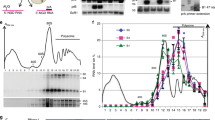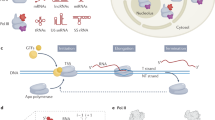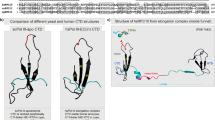Abstract
Production of messenger RNA in eukaryotic cells is a complex, multistep process. mRNA polyadenylation, or 3′ processing, requires several protein factors, including cleavage/polyadenylation-specificity factor (CPSF), cleavage-stimulation factor, two cleavage factors and poly(A) polymerase (reviewed in refs 1, 2). These proteins seem to be unnecessary for other steps in mRNA synthesis such as transcription and splicing, and factors required for these processes were not considered to be essential for polyadenylation. Nonetheless, these reactions may be linked so that they are effectively coordinated in vivo3,4,5,6,7,8,9. For example, the CTD carboxy-terminal domain of the largest subunit of RNA polymerase II (RNAP II) is required for efficient splicing and polyadenylation in vivo8, and CPSF is brought to a promoter by the transcription factor TFIID and transferred to RNAP II at the time of transcription initiation9. These findings suggest that polyadenylation factors can be recruited to an RNA 3′-processing signal by RNAP II, where they dissociate from the polymerase and initiate polyadenylation. Here we present results that extend this model by showing that RNAP II is actually required, in the absence of transcription, for 3′ processing in vitro.
This is a preview of subscription content, access via your institution
Access options
Subscribe to this journal
Receive 51 print issues and online access
$199.00 per year
only $3.90 per issue
Buy this article
- Purchase on Springer Link
- Instant access to full article PDF
Prices may be subject to local taxes which are calculated during checkout




Similar content being viewed by others
References
Wahle, E. & Keller, W. The biochemistry of polyadenylation. Trends Biochem. Sci. 21, 247–250 (1996).
Colgan, D. F. & Manley, J. L. Mechanism and regulation of mRNA polyadenylation. Genes Dev. 11, 2755–2766 (1997).
Niwa, M., Rose, S. D. & Berget, S. M. In vitro polyadenylation is stimulated by the presence of an upstream intron. Genes Dev. 4, 1552–1559 (1990).
Gunderson, S. I. et al. The human U1A snRMP protein regulates polyadenylation via direct interaction with poly(A) polymerase. Cell 76, 531–541 (1994).
Lutz, C. S. et al. Interaction between the U1 snRNP-A protein and the 160-kD subunit of cleavage–polyadenylation specificity factor increases polyadenylation efficiency in vitro. Genes Dev. 10, 325–337 (1996).
Yuryev, A. et al. The C-terminal domain of the largest subunit of RNA polymerase II interacts with a novel set of serine/arginine-rich proteins. Proc. Natl Acad. USA 93, 6975–6980 (1996).
Mortillaro, M. J. et al. Ahyperphosphorylated form of the large subunit of RNA polymerase II is associated with splicing complexes and the nuclear matrix. Proc. Natl Acad. USA 93, 8253–8257 (1996).
McCracken, S. et al. The C-terminal domain of RNA polymerase II couples mRNA processing to transcription. Nature 385, 357–361 (1997).
Dantonel, J. C., Murthy, K. G. K., Manley, J. L. & Tora, L. CPSF links transcription and mRNA 3′ end formation. Nature 389, 399–402 (1997).
Hirose, Y. & Manley, J. L. Creatine phosphate, not ATP, is required for 3′ end cleavage of mammalian pre-mRNA in vitro. J. Biol. Chem. 272, 29636–29642 (1997).
Matthews, H. R. Protein kinases and phosphatases that act on histidine, lysine, or arginine residues in eukaryotic proteins: a possible regulator of the mitogen-activated protein kinase cascade. Pharmacol. Ther. 67, 323–350 (1995).
Takagaki, Y., Ryner, L. C. & Manley, J. L. Four factors are required for 3′-end cleavage of pre-mRNAs. Genes Dev. 3, 1711–1724 (1989).
Takagaki, Y., Ryner, L. C. & Manley, J. L. Separation and characterization of a poly(A) polymerase and a cleavage/specificity factor required for pre-mRNA polyadenylation. Cell 52, 731–742 (1988).
Christofori, G. & Keller, W. 3′ cleavage and polyadenylation of mRNA precursors in vitro requires a poly(A) polymerase, a cleavage factor, and a snRNP. Cell 54, 875–889 (1988).
Colgan, D. F., Murthy, K. G. K., Prives, C. & Manley, J. L. Cell-cycle related regulation of poly(A) polymerase by phosphorylation. Nature 384, 282–285 (1996).
Colgan, D. F., Murthy, K. G. K., Zhao, W., Prives, C. & Manley, J. L. Inhibition of poly(A) polymerase requires p34cdc2/cyclin B phosphorylation of multiple consensus and non-consensus sites. EMBO J. 17, 1053–1062 (1998).
Manley, J. L. & Tacke, R. SR proteins and splicing control. Genes Dev. 10, 1569–1579 (1996).
Lou, H., Gagel, R. F. & Berget, S. M. An intron enhancer recognized by splicing factors activates polyadenylation. Genes Dev. 10, 208–219 (1996).
Dahmus, M. E. Reversible phosphorylation of the C-terminal domain of RNA polymerase II. J. Biol. Chem. 271, 19009–19012 (1996).
Lu, H., Flores, O., Weinmann, R. & Reinberg, D. The nonphosphorylated form of RNA polymerase II preferentially associates with the preinitiation complex. Proc. Natl Acad. USA 88, 10004–10008 (1991).
Besse, S., Vigneron, M., Pichard, E. & Puvion-Dutilleul, F. Synthesis and maturation of viral transcripts in herpes simplex virus type 1 infected HeLa cells: the role of interchromatin granulates. Gene Expr. 4, 143–161 (1995).
Dignam, J. D., Lebovitz, R. M. & Roeder, R. G. Accurate transcription initiation by RNA polymerase II in a soluble extract from isolated mammalian nuclei. Nucleic Acids Res. 11, 1475–1489 (1983).
Takagaki, Y., Manley, J. L., MacDonald, C. C., Wilusz, J. & Shenk, T. Amultisubunit factor, CstF, is required for polyadenylation of mammalian pre-mRNAs. Genes Dev. 4, 2112–2120 (1990).
Reinberg, D. & Roeder, R. G. Factors involved in specific transcription by mammalian RNA polymerase II. J. Biol. Chem. 262, 3310–3321 (1987).
Zahler, A. M., Lane, W. S., Stolk, J. A. & Roth, M. B. SR proteins: a conserved family of pre-mRNA splicing factors. Genes Dev. 6, 837–847 (1992).
Peterson, S. R., Dvir, A., Anderson, C. W. & Dynan, W. S. DNA binding provides a signal for phosphorylation of the RNA polymerase II heptapeptide repeats. Genes Dev. 6, 426–438 (1992).
Flaherty, S. M., Fortes, P., Izaurralde, E., Mattaj, I. W. & Gilmartin, G. M. Participation of the nuclear cap binding complex in pre-mRNA 3′ processing. Proc. Natl Acad. USA 94, 11893–11898 (1997).
Harlow, E. & Lane, D. Antibodies: A Laboratory Manual (Cold Spring Harbor Laboratory Press, Cold Spring Harbor, New York, (1988)).
Acknowledgements
We thank C. Li for the RNAP II used in Fig. 1 and for discussion; X. Sun and D.Reinberg for purified RNAP IIB; K. G. K. Murthy for recombinant PAP and antibodies; R. Tacke for purified SR proteins; W. S. Dynan for the GST–CTD plasmid; L. Tora, C. Kedinger and M. Vigneron for mAb 7G5; X. H. Shi, Y. Chen and Y. Sun for help in preparing nuclear extracts; and J. Dahlberg for suggesting that arginine phosphate might function by mimicking a phosphoarginine-containing protein. This work was supported by a grant from the NIH to J.M.; Y.H. was partly supported by the Japanese Ministry of Education, Science, and Culture.
Author information
Authors and Affiliations
Corresponding author
Rights and permissions
About this article
Cite this article
Hirose, Y., Manley, J. RNA polymerase II is an essential mRNA polyadenylation factor. Nature 395, 93–96 (1998). https://doi.org/10.1038/25786
Received:
Accepted:
Issue Date:
DOI: https://doi.org/10.1038/25786
This article is cited by
-
Human Satellite 1A analysis provides evidence of pericentromeric transcription
BMC Biology (2023)
-
Alternative polyadenylation by sequential activation of distal and proximal PolyA sites
Nature Structural & Molecular Biology (2022)
-
Importance of amino acids Leu135 and Tyr236 for the interaction between EhCFIm25 and RNA: a molecular dynamics simulation study
Journal of Molecular Modeling (2018)
-
4sUDRB-seq: measuring genomewide transcriptional elongation rates and initiation frequencies within cells
Genome Biology (2014)
-
Coupling mRNA processing with transcription in time and space
Nature Reviews Genetics (2014)
Comments
By submitting a comment you agree to abide by our Terms and Community Guidelines. If you find something abusive or that does not comply with our terms or guidelines please flag it as inappropriate.



